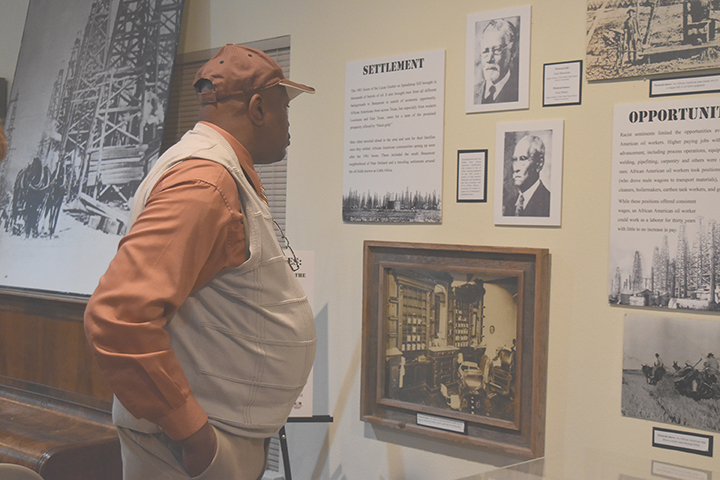Boomtown Museum hosts exhibit of African American experiences, history

The Spindletop Gladys City Boomtown Museum opened the exhibition “Spindletop Stories: African American Oil Workers,” Jan. 31, featuring the contributions of African Americans during the Spindletop oil boom.
In 1901, oil was discovered at Spindletop. Found at a depth of 1,000 feet and blowing 100 feet in the air, oil flowed from the Lucas Gusher at a rate of 100,000 barrels a day.
“This transformed the city of Beaumont and helped kick start the modern petroleum industry,” curator Hannah Colletti said.
The population of Beaumont increased from 10,000 to 50,000 after the discovery of oil. Because Beaumont’s infrastructure was limited and boomtowns grew around the oil fields, including Little Africa, which was a settlement that included a high African American population.
Ednesha Cook researched the Little Africa boomtown during her senior internship at the Spindletop Museum in 2015.
“One of the most interesting things was finding newspaper articles about Little Africa,” Cook said. “They were trying to make a living, and the newspapers covered their hardships and how they had to endure racial prejudice, and people coming into the town and looting. It was interesting but at the same time heartbreaking.”
At the time of the boom, African Americans were working in the lumber industry and owned land and businesses, but were limited in what they could do at Spindletop.
“African American workers were not allowed to work on the rigs,” Colletti said. “They often did work like haul materials, clean tools and repair tanks. But the higher paying positions were reserved for white men.”
When curating the exhibit, Colletti had trouble finding photographs of the African American oil workers.
“The written information was definitely there, but the visual confirmation was not.” she said. “There’s a gap in the visual narrative.”
Two half-brothers, Ozan Blanchette and Usan Hebert, are featured in the exhibition. Blanchette and Hebert were involved in building the community and establishing schools.
“They were land owners who sold large portions of land to fellow oil workers that went on to become modern day Pear Orchard,” Colletti said.
David Hebert, the second great grandson of Usan, sponsored the exhibit and contributed to the research.
In 2015, David Hebert read an article in the Beaumont Enterprise about an African American oil workers exhibit at the Spindletop Museum.
“I created a family day,” he said. “I brought my father, my uncle, my cousin — we came here and we were like, ‘We want to see the exhibit.’”
When David and his family arrived, the exhibit did not yet exist. Inspired by his familial connections to the topic, Hebert agreed to being on the advisory council of the exhibit.
“I was gonna do whatever it took — if it meant offering funds, materials or artifacts,” he said.
Hebert donated a band directors uniform from Hebert High School from 1955 that he was given during the recent merger of Ozen High School and Central High School to create Beaumont United.
“I think everyone who lives in this community has a personal connection to this story,” Colletti said. “It is a story worth telling. We learn in history. A lot of the time, the main narratives are written by the majority and the smaller narratives fall to the wayside, but they are just as important to the overall picture.”
“History does not preserve itself — we have to do it,” David Hebert said.
The Spindletop Stories exhibit is open until June 30. Admission is free for LU students, and general admission is $5.
For more information, visit www.spindletop.org, or call 880-1750.
Story by Claire Robertson, UP contributor
